Saturday, July 9. 2011
This is one of our Pee Wee Oakleaf Hydrangeas. It shows what happens when you prune them: almost no blooms. Even though it is a dwarf version Oakleaf, it outgrew its space and I had to shape it aggressively this winter.
Next year, it will be fine if I leave it alone.
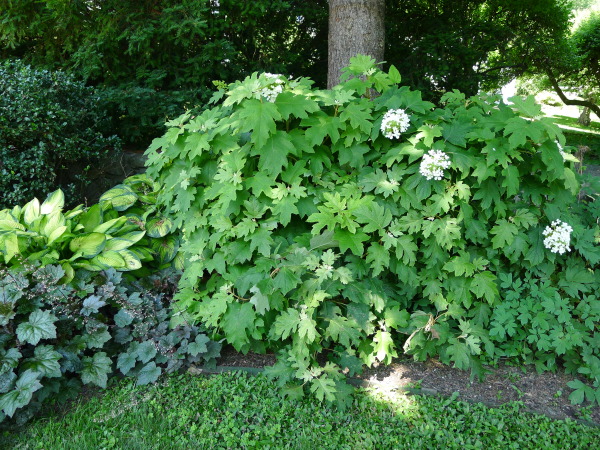
Wednesday, July 6. 2011
One of our white mophead varieties - Blushing Bride - in bloom right now, and, in typical hydrangea style, with a little mid-day wilt from being planted (by me) in a tad too much sunshine:
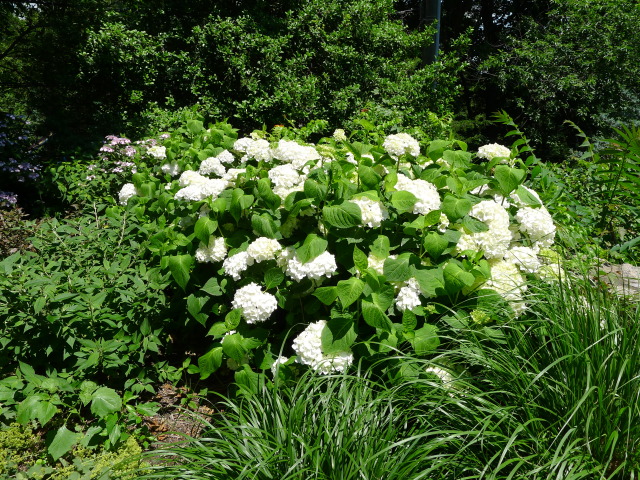
Monday, July 4. 2011
Time-saving projects always take more time than one expects.
We have always been partial to a gardening mix with hanging baskets, large pots, and planters. According to my local expert Mrs. BD, pots can add structure and height to flower gardens. The only thing that drives her nuts are clashing colors, and she does not like to permit annuals to steal the show from precious perennials and flowering shrubs with their frequently more subtle colors. (Furthermore, she believes that varied and interesting foliage is just as important in a garden as are blooms.) Red annuals? Fugeddaboutit. She says they are for McDonald's and banks - commercial-looking. She is right that overly-bright flowers look commercial and tacky rather than homey unless they are the only thing you are growing.
You could say that she feels that using any annuals is cheating, but I am not so doctrinaire about the elite gardening rules.
Our gardening trick for in-ground gardens is to use plenty of mulch instead of using irrigation, but if you enjoy pots and planters the way the Italians do, and do not always remember to, or bother to, lug watering cans around every night or every morning with all of the other things that need doing, you can assemble one of these sorts of cool dripper systems, set the timer, and forget about them until frost. Our cousins on Nantucket use them for all of their rental houses, and they work great. The mini-hoses are invisible.
Trust me. They'll look much better and grow better with daily water. Pots and planters dry out in one sunny summer day. (Smaller pots don't even make it through a day.) The occasional light dose of Miracle Gro in planters doesn't hurt either.
Saturday, July 2. 2011
An annual re-post -
 Everybody has an opinion on pruning tomato plants. Here's my view of the subject. Everybody has an opinion on pruning tomato plants. Here's my view of the subject.
First, I'll assume we are growing "Indeterminate" types of tomatoes, i.e. vine tomatoes as opposed to the tree-like ("determinate," aka "bush" tomatoes) ones often grown in pots. Left alone, vine tomatoes will grow 10+ feet along the ground, as you can often see in gardens in Bermuda, but we stake them.
Up here in New England (Yankeeland), we need to prune them because our short growing season doesn't allow much time for good fruit formation. We have to prune most of the suckers and plenty of their leaves, and we cut their tops off in July or August - all so they will put their energy into good fruit and not into further pointless growth.
Further south, diligent pruning is less important.
And even though I grow mine in fine soft soil, I fertilize them with liquid fertilizer whenever I think of it. I usually have lots of plants, but only ended up with 10-12 this year of around 5 varieties.
Here's the best site I have seen on indeterminate tomato vine gardening. For all of the effort, and despite our short season, it is well-worth it when you pick one on a hot day and eat it in the garden like an apple. A tomato should be hot, with little salt on it.
Image: Commercial tomato picking in North Carolina
Friday, July 1. 2011
Another one of our hydrangeas, a lacecap variety, in bloom right now. Late June/early July is Hydrangealand up here. It happens right after the first bloom of the roses fade, and we try to have at least one variety in bloom through the entire summer:
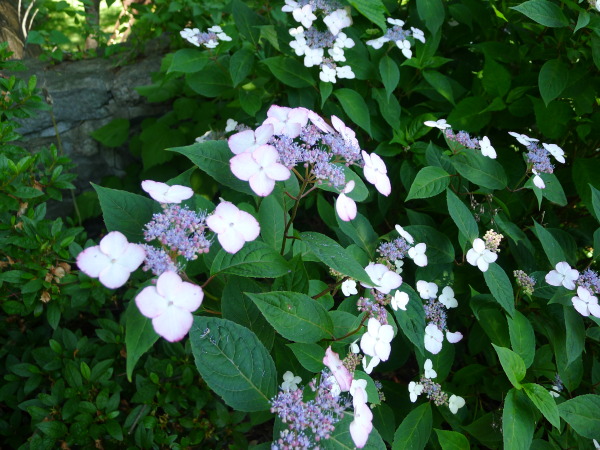
Tuesday, June 28. 2011
The Nikko Blue hydrangea and its variants are classic plants in Yankeeland. Mine are in their full glory today.
Hydrangeas are the sorts of things that make a house a home.
Here are three important tips for those who grow hydrangeas of any type: first, they like moist (but well-drained) soil, hence their name. Second, full-day direct sun is too much for most of them unless you have irrigation. Third, prune them with caution: you have to first determine whether they are macrophylla or paniculata, etc. Prune them wrong and you get no bloom. Better yet, don't prune them at all unless you have to.
(More general shrub pruning info: Except for hedging or shaped shrubs, mature shrubs can or should be pruned at ground level - not from the top - removing 25-30% of the woodiest growth to keep the plant young and vigorous. This is especially important with shrubs like Lilacs. I will try to dig out my old pruning posts. Always study the correct pruning technique for a given plant before attacking anything with a sharp tool. Never prune young shrubs.)
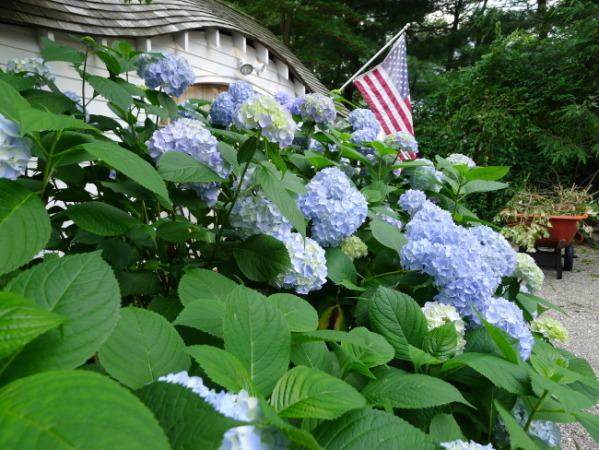
Sunday, May 29. 2011
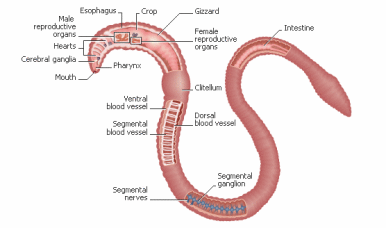 I was surprised to stumble upon the fact that the common earthworm, the gardener's friend, is not native to the US and Canada: most worm species are "invasive" introductions from Europe, and have been spread across the country in plant material. I was surprised to stumble upon the fact that the common earthworm, the gardener's friend, is not native to the US and Canada: most worm species are "invasive" introductions from Europe, and have been spread across the country in plant material.
A few more interesting facts:
- The earthworm has been very destructive to several types of forest habitat by consuming deep forest litter (leaves). Ecologists consider them invasive pests in some habitats.
- Earthworms are killed by most pesticides. Fertilizer doesn't seem to bother them.
- Darwin calculated that earthworms can recycle and refresh the surface soil to the tune of 10 tons of soil per acre per year. Count me as a skeptic on that number, but they do churn the soil.
- Yes, some species of earthworm can regenerate lost body segments. No need for tears when you chop one with the shovel.
- Worms need food. For a wormy lawn or garden, it needs to be top-dressed or mulched with organic material. I do a generous top-dressing of peat moss or well-rotted cow manure once or twice twice a year, and after the heavy spring lawn growth, I leave the grass clippings where they fall. I like to mulch up the early autumn fallen leaves with the mowers, too.
A green lawn treated with pesticides, nurtured solely with inorganic fertilizers, and with automatic irrigation, is little more than a corpse with make-up.
More here and here.
Tuesday, April 26. 2011
 Serious gardeners in New England, especially food-gardeners, build coldframes to extend the growing season. Properly done, you can add at least a month to the growing season for some things. Serious gardeners in New England, especially food-gardeners, build coldframes to extend the growing season. Properly done, you can add at least a month to the growing season for some things.
I used to mess with things like that, but I don't bother anymore. If I lived in Maine, though, I'd definitely have a coldframe full of spinach, leaf lettuces, etc.
I've even tried putting tomatoes out in late April here, but it never works out. Milk jugs, polyurethane, etc. Big hassle. Fact is, around here, if you put them out in late May they quickly catch up to the early birds, and even exceed them because they have endured no cool weather stresses. Tomatoes do not really put on growth without warm nights - above 55 F. We are still in the 30s on some nights.
If you have money to burn, the best thing is a good-sized real greenhouse. I would attach one to the house, with interior and exterior doors, so you could just open the door and let the rich earthy and flower and herb and plant smells infuse the house. Home-grown Beefsteak tomatoes 12 months/year.
Pic is Beefsteaks, the only tomato I truly enjoy eating, especially when hot from the sun. We usually only get a few weeks of them ripening, mid-late August-early September. Is it worth the trouble? For me, it is. It is especially pleasant when you can find a big ripe one that a squirrel or chipmunk has not taken a bite out of.
Sunday, April 17. 2011
An annual re-post -
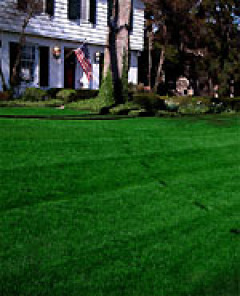 We always contend that lawns are foolish things to have. Foolish, and unnatural. We prefer meadows and gardens, but everybody needs a place to play croquet or softball, or to lie in the sun with a book, growing your basal cell carcinomas and your liver spots. We reluctantly acknowledge that, in some suburban areas, a sweeping lawn is a social if not an aesthetic requirement. We always contend that lawns are foolish things to have. Foolish, and unnatural. We prefer meadows and gardens, but everybody needs a place to play croquet or softball, or to lie in the sun with a book, growing your basal cell carcinomas and your liver spots. We reluctantly acknowledge that, in some suburban areas, a sweeping lawn is a social if not an aesthetic requirement.
All the same, we urge folks to consider how much of that lawn they might exchange for some more interesting colorful perennial or shrub borders and ground covers. A nice English garden, whether formal or informal, uses lawn as an accent and for paths - as just one component of design and mentally, I think, as a comforting symbol of safe civilization to contrast with the blooming profusion of the other plantings. Order vs. disorder. Open vs. closed. Safe vs. mysterious. Landscape design is a psycho-spiritual enterprise. This is a garden outside of London:
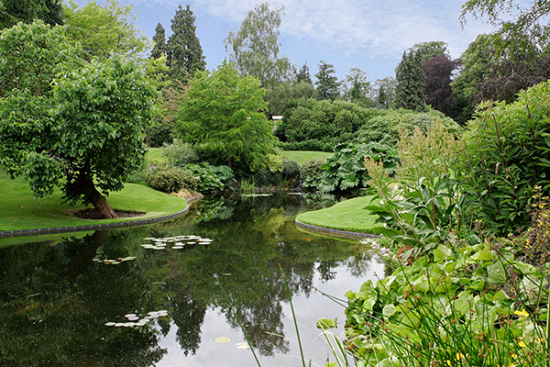
Here's a brief history of the American lawn. Yes, the lawn is more-or-less designed to imitate the smooth effect of a sheep-grazed pasture on an English country estate.
And here is our world-famous bit on top-dressing and other lawn topics.
Today, a bit about lawn aeration, fertilizer, irrigation, earthworms, and "de-thatching." In reverse order:
 "De-thatching" is a completely useless and unnecessary activity. No healthy soil needs it, and a healthy soil is the key to a decent sod. "Thatch" - old grass - will rapidly decompose or be eaten by worms in a good lawn, recycling the nutrients and keeping your worms fat and happy. "De-thatching" is a completely useless and unnecessary activity. No healthy soil needs it, and a healthy soil is the key to a decent sod. "Thatch" - old grass - will rapidly decompose or be eaten by worms in a good lawn, recycling the nutrients and keeping your worms fat and happy.
Earthworms. We said everything we know about the wonderful earthworm in this post. They aerate and enrich the sod. If your sod doesn't contain plenty of them, something is wrong with it.
Irrigation. No natural lawn requires irrigation. If you try to grow lawn grasses in places they don't want to grow, like the Arizona desert, they will need irrigation of course. Around here, people with money to burn irrigate their lawns to trick the grass into staying green all summer, and not enter their natural summer dormancy when they are apt to turn brown. Lawn grasses grow the way they do because our mowing cuts their tops off while they keep trying to grow to their natural height and to bear their seeds. It must be frustrating to the poor things. In natural conditions, grasses grow to their full height, bear their seeds (say, in early July) and then go dormant until cool damp weather brings them back to life. If you keep them strugging at their Sisyphisian effort through the mid-summer with irrigation, they will naturally need more fertilizer to look photogenic.
Fertilizer and top-dressing. Our lawns do need fertilizer because they are deprived of natural sources of nutrients (fallen leaves, animal droppings, clover and other wild legumes with their nitrogen-fixing bacteria, silting from flooding, etc). When you bag or blow the clippings, then even more so - and you starve the worms, too. My top-dressing program not only fertilizes organically, but also improves the soil texture. I also fertilize lawns in June and September/October. I don't use water-soluble nitrogen, because most that will end up in the stream. I use mowing machines that mulch the clippings and fallen leaves. I don't need to use herbicides, because the grass is happy. And I don't use pesticides because there is no good reason to waste the money and to poison Creation.
Aeration. In nature, earthworms, moles, woodchucks, and other digging critters keep the topsoil loose and in motion. Loose soil is need for root growth, water and nutrient penetration, and to provide air for aerobic soil microbes. Our lawns tend to get compacted, and people try to kill their happy moles because they interfere with the "perfect lawn" (which, of course, is meant to be a reflection of our perfect selves, right?). Aeration of lawns and sports fields is essential, and should be done depending on how heavily the grass is tromped on. Some lawns, every two years. Sports fields need twice per year. There are two kinds of aerators. The spike aerators (like this) do nothing useful. What is needed is the plugger type (like this one, in photo above), which pulls out forty-fifty per square yard 2-4"-deep plugs out of the sod and deposits them on the surface. (it makes a temporary mess, but one good heavy rain removes most evidence of the plugs.) Plug aeration is commonly done in the Fall, but I like to do it in the Spring, after the grass gets growing thick and vigorously (May), and combine it with my biennial top-dressing project and with any overseeding that seems needed.
The downside of plugging is having dogs with muddy feet on your bed for a couple of days.
Sunday, March 27. 2011
 I use Preen on our perennial beds and shrub borders. I think Mrs. BD, the Weeder-in-Chief, appreciates it, but my Mom gives me heck for using it since she views it as lazy and possibly not environmentally acceptable. I use Preen on our perennial beds and shrub borders. I think Mrs. BD, the Weeder-in-Chief, appreciates it, but my Mom gives me heck for using it since she views it as lazy and possibly not environmentally acceptable.
As I understand it, it mainly prevents seeds from germinating. What's wrong with that? Yes, we mulch too, but seeds germinate in mulch.
Weeding plantings to make fresh space for the new weeds no longer interests me. I'd rather be playing tennis.
Tuesday, March 15. 2011
An annual re-post -
 Lawns are dumb things to have, but almost everybody has some. It's expected nowadays, but gardens and plantings are more interesting, look more natural, are more inviting to birds and other friendly critters, and offer more privacy - and shade. On the other hand, everyone needs a space for croquet and badminton. Lawns are dumb things to have, but almost everybody has some. It's expected nowadays, but gardens and plantings are more interesting, look more natural, are more inviting to birds and other friendly critters, and offer more privacy - and shade. On the other hand, everyone needs a space for croquet and badminton.
Once the preserve of the wealthy, lawns became de rigeur for the aspiring middle class during the 20th century, as new homeowners attempted to create miniaturized versions of grand English estates on 1/4, 1/2, 1- and 2-acre building lots.
The orgin of lawns was sheep-grazed fields. Sheep are the primitive machine which transforms grass into wool and mutton.
But the subject assigned to me is top dressing. (Bear in mind that I am talking about Northern and mid-western lawns with Bluegrass and fescue in them. That's all I know about. Southern lawns are an entirely different breed.)
I top dress my lawns every spring, and I know Bird Dog does too. He does it casually, but I do it methodically. I mix about 1/4 leaf compost, 1/8 light sand, 1/8 topsoil or potting soil, 1/4 peat moss and 1/4 composted manure in the big wheelbarrow and toss it around the ground after around the second grass cutting of spring. Probably plain peat moss or composted manure would do the trick just as well. Ideally, it all should be rather dry, but life is never ideal. Then I lightly rake it in - or have the lawn guys rake it in - so it doesn't compress the grass. I apply it rather heavily, and use around 40 wheelbarrow loads for the lawn areas I care about.
It's about stewardship of the land, and not a cheap nitrogen-intoxicated superficial green. We have to remember that lawns are not natural things, but they aren't plastic either.
(More lawn info and advice below the fold)
Continue reading "Top dressing, and lawns in general, for your Spring chores list"
Thursday, December 9. 2010
Sunday, November 28. 2010
Now is the right but final time to fertilize fruit trees, grape vines, ornamental trees, etc. in northern climes.
Those roots are alive and hungry right now, storing up fat for Spring before they go dormant - even though the leaves are off. Just go easy with the fertilizer on the apple trees. Excess fertilizer encourages rusts. Too little is better than too much for them.
And, while we're at it, don't forget to try my trick. If you have good strong perennial herbs in pots (sage, marjoram, thyme), turn the pots upside down in the dirt for the winter. Odds are that they will spring back to life with a vengeance when global warming warms things up in April. Even it they don't, it will protect your pots from cracking from ice.
I bring my 3 year-old Rosemary bush indoors, but people might have better ideas for that. I like having it in the kitchen so I can run my hands though it. Makes me smell good. It barely survives the winter, but jumps back to life when we cut it back, and put it outdoors in April. My bro keeps his potted Rosemary in his garage, like some people do with their figs. (I let my fig rough it. I just throw a tarp over it and hope for the best.) One of these years, I will plant my Rosemary next to the foundation and cover it with a couple of layers of polyurethane for the winter. The goal would be to have a 6' Rosemary bush like they have at Oxford, and everywhere in Italy.
This guy in CA proudly posted his healthy but ramshackle Rosemary hedge:
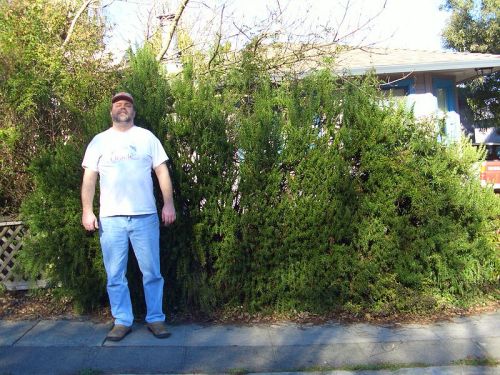
Saturday, October 23. 2010
I have a fatal disease in my large, probably 100 year-old Copper Beech tree. I have diagnosed it as Beech Bark Disease. I've seen the same bark disease on many old Copper Beeches recently - areas of shedding bark on the trunk and dying branches high overhead. It's a damn shame.
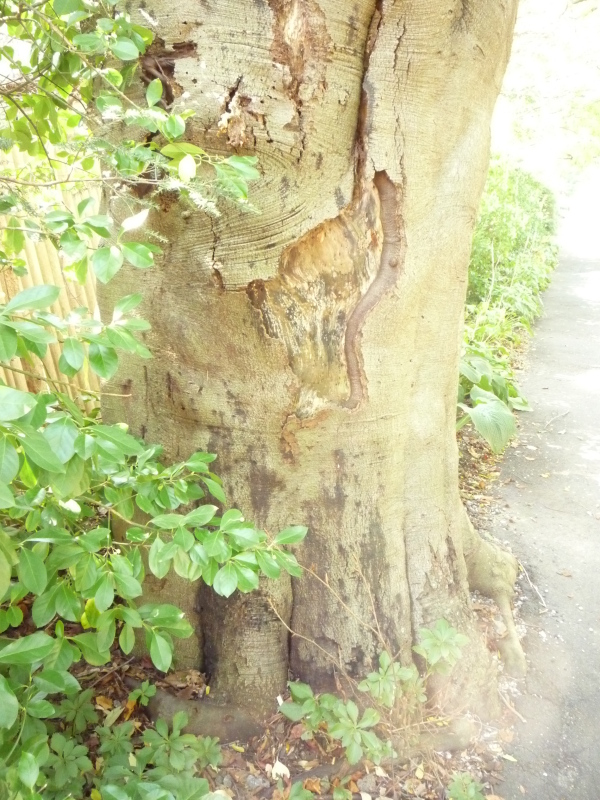
Tuesday, August 17. 2010
Great tool for the places wheere you cannot take a tractor. It's the 17 HP, and it will shred a 2" sapling with ease. Here's the DR site.
Can you name year and make of the truck?

Monday, August 16. 2010
Ten years ago we sat with a good pal, now deceased, and his wife on the porch of his golf club, sipping after-dinner single malts and smoking Cubans. And watching the Hummingbird Moths who were all over the solid planting of pink Cleome below the porch.
One of those magical moments. There are other reasons to plant annuals like Cleome, but those moths at dusk are the best reason. Here's a pic of one from Gardener's Index hovering over a Cleome:
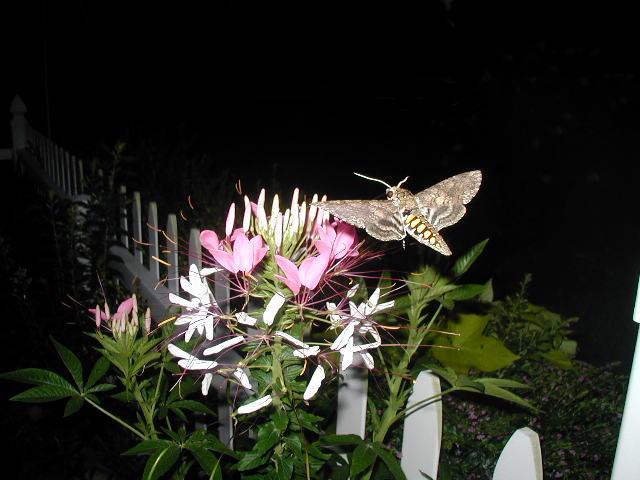
Monday, August 9. 2010
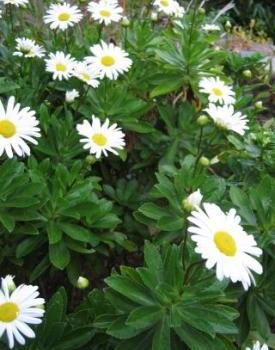 Anybody who took my advice about growing Montauk Daisies, the succulent daisy which is a cultivar of the Seaside Daisy (common on Cape Cod, and totally different from the West Coast's beach daisy), is missing one piece of info which I have learned only now. Anybody who took my advice about growing Montauk Daisies, the succulent daisy which is a cultivar of the Seaside Daisy (common on Cape Cod, and totally different from the West Coast's beach daisy), is missing one piece of info which I have learned only now.
Yes, these wonderful late-bloomers are worth growing, but they need to be prunced twice. First, cut down to 6" in the later winter, but then again to around 14-16" in May. That's the trick to keeping them from becoming too leggy and sort-of falling apart.
I learned this yesterday. If you like these heat and drought-tolerant autumn-bloomers, remember that for next year. Mine are flopping all over now, before blooming as they always do, and I never bothered to ask a pro about it.
Like the Beach Rose, the Montauk Daisy originated in Japan.
Saturday, August 7. 2010
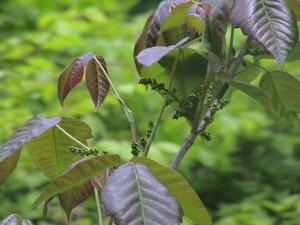 Mrs. BD reports today, after trying Gibbs' recommendation, that a paste of vinegar and baking soda is quite effective for poison ivy. (Remember McGeek's case of poison ivy?) Mrs. BD reports today, after trying Gibbs' recommendation, that a paste of vinegar and baking soda is quite effective for poison ivy. (Remember McGeek's case of poison ivy?)
Mrs. BD is highly sensitive to poison ivy, but when she gets weeding she stops paying attention and just rips along like a weeding machine.
Gibbs is usually right about things. I made her take some Benadryl too. Partly to compete with Gibbs, I guess.
Saturday, July 17. 2010

A quote from "Harnessing the Earthworm" by Dr. Thomas J. Barrett, Humphries, 1947, with an Introduction by Eve Balfour; Wedgewood Press, Boston, 1959:
For more than sixty years these 160 acres had been farmed without a single crop failure. My grandfather was known far and wide for the unequalled excellence of his corn and other grain, and a large part of his surplus was disposed of at top prices for seed purposes. The farm combined general farming and stock raising; my grandfather's hobby, for pleasure and profit, was the breeding and training of fine saddle horses and matched Hambletonian teams. He maintained a herd of about fifty horses, including stud, brood mares, and colts in all stages of development. In addition to horses, he had cattle, sheep, hogs, and a variety of fowl, including a flock of about five hundred chickens which had the run of the barnyard,with a flock of ducks. Usually about three hundred head of stock were wintered. The hired help consisted of three or four men, according to the season, with additional help at rush seasons. This establishment was maintained in prosperity and plenty, and my grandfather attributed his unvarying success as a farmer to his utilization of earthworms in maintaining and rebuilding the fertility of the soil in an unbroken cycle. The heart of the farming technique was the compost pit.
It takes you back in time. Read the whole essay, My Grandfather's Earthworm Farm
Monday, July 5. 2010
I'll wrap up my Newport photo dump with a few pics from the Flower Show, which is the main reason Mrs. BD dragged me to Rhode Island last weekend. The Newport Flower Show is what the gardening and arranging ladies term an "important" show. It attracts garden club competitors from as far as Texas, and it raises lots of money for the Preservation Society of Newport County.
Mrs. BD did not have an entry in the show this year, but she likes to keep a finger on the pulse of things.
Last weekend's show was held at Rosecliff, one of the loveliest Newport cottages. Guy who built it was a Comstock Lode heir. My photos do not capture how crowded the place was with flower people and their tolerant husbands, mostly, like me, feigning deep interest and appreciation while furtively glancing at one's watch.

More pics of the show below the fold -
Continue reading "The Newport Flower Show"
Sunday, June 20. 2010

Re-posted today because I had a female Ruby-Throated flirting with me yesterday while I was watering some hanging baskets of flowers. Fearless critter. Seemed to want to frolic in the spray.
Chances are that the first time you saw a hummingbird, you paid it no attention, imagining it to be a passing dragonfly or some other fleeting buzzing bug. In the Eastern half of the US, we have only one species the Ruby Throated.
This 3-4-inch bird is usually only seen when hovering over flowers, because otherwise he is tiny and darting in flight, and his wings are a humming blur. You have to be very close to hear the hum.
These insect-like birds are probably more abundant in your area than you realize, but if you want to see them often, you need a hummingbird garden. (Those sugar-water hummingbird feeders offer no real nutrition, and the red coloring is thought to be somewhat toxic.) He feeds on nectar and small bugs hidden in the flowers, and prefers flowers which are designed for pollination by hummingbirds often red in color and vase-shaped for his long beak. Red Trumpet Vine (in photo) is a favorite, as is azalea in the south, but they like monarda too. I find their favorite at my place is Crocosmia which is in bloom now along with the monarda, and the trumpet vine on my wall. I highly recommend Crocosmia the bulbs are a bit expensive but, once established, they multiply rapidly and they have attractive foliage. White Flower Farm has a large selection. In the woods, I typically see hummingbirds around patches of Jewelweed, which likes damp areas.
Read more about the Ruby Throated here. How do these fragile creatures make it across the Gulf of Mexico to winter in South America?
The print is Audubon's, the Ruby Throat with Trumpet Vine.
Speaking of hummingbirds, dont forget the Dixie Hummingbirds.
Friday, June 11. 2010
Our planting and transplanting season is now done, as is my anniversary gift to Mrs. BD which entailed two solid weekend days of being a submissive garden slave, taking all orders with shovel, wheelbarrow, trimmers, saws, mulch, and the final load of plantings. Beer breaks and a couple of ceegars, natch. I am the brawn, she is the brains.
Transplanting shrubs and perennials is like musical chairs. There is always at least one thing that ends up with no place to go, and is left to die, roots up in the sun. Murder.
Mrs. BD has been getting interested in putting dwarf shrubs in perennial borders in recent years. In this bed, we had moved some hybrid Rhodies out two months ago, and moved those lacecap hydrangeas back against the wall (they will revive just fine, but look a little wan right now). That left a hole for these three new red-leafed dwarf Weigelas to the left of the dwarf Buddleas. It will all fill in nicely in a year or so with the goal, of course, being no space between plants for weeds to grow:
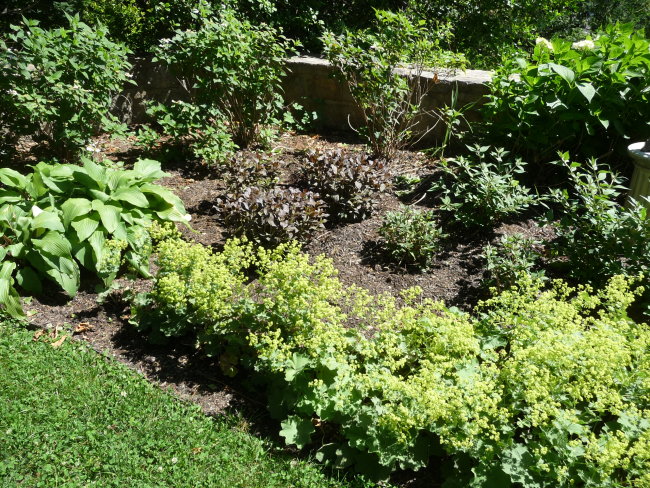
The edge is Lady's Mantle, in full bloom. It makes a solid and subtle perennial edge with its pale yellow-green florets.
Here's one site with dwarf Weigelas.
Friday, June 4. 2010
Hereabouts, it's time to yank out the Spring pansies. Many people have the nurseries fill their planters right about now, but people like Mrs. BD like to do them herself.
She says all you need to know is that a planter needs one thriller, a few spillers, and filler - with interesting foliage contrast and compatible color. It's a form of flower arranging. In a couple of weeks, these pots will be looking good:
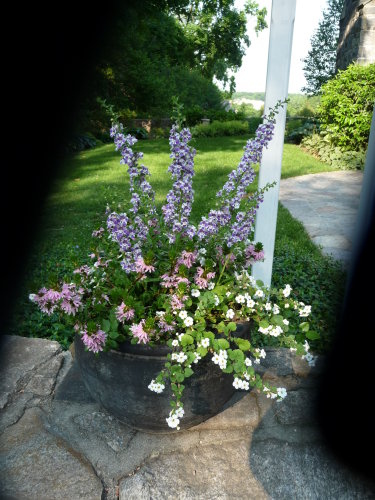
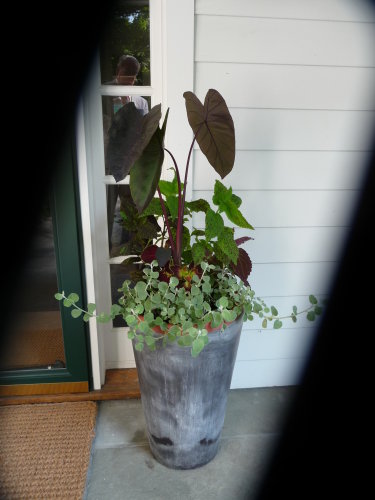
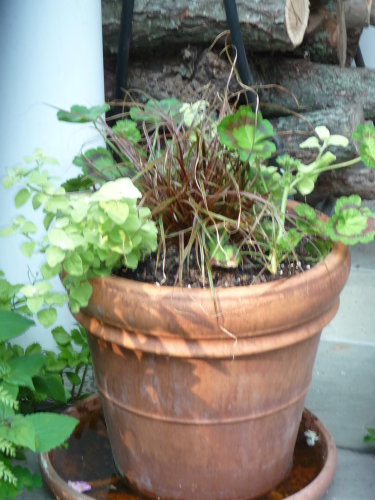
Monday, May 31. 2010
Also known as Catmint (it is related to Catnip). It's a long-blooming front-of-the-border plant, and will re-bloom later if the exhausted blooms are cut off. It comes in a few cultivars of varying heights.
This was yesterday. Note the happy Digitalis on the left. Little Lamb's Ear Hydrangea in front.
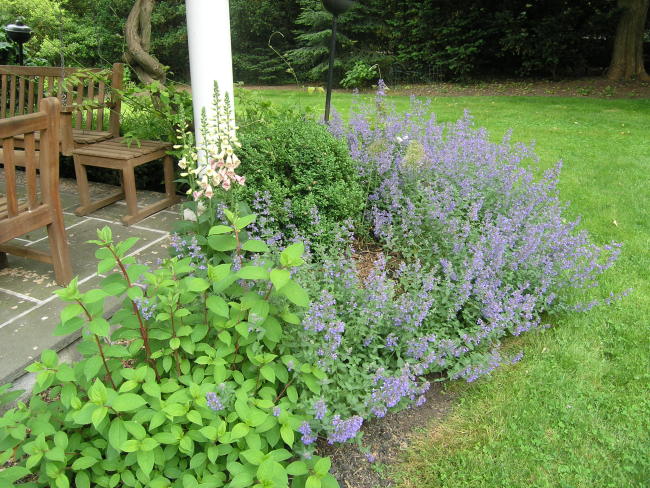
|


 Everybody has an opinion on pruning tomato plants. Here's my view of the subject.
Everybody has an opinion on pruning tomato plants. Here's my view of the subject. I was surprised to stumble upon the fact that the common earthworm, the gardener's friend, is not native to the US and Canada: most worm species are "invasive" introductions from Europe, and have been spread across the country in plant material.
I was surprised to stumble upon the fact that the common earthworm, the gardener's friend, is not native to the US and Canada: most worm species are "invasive" introductions from Europe, and have been spread across the country in plant material. Serious gardeners in New England, especially food-gardeners, build
Serious gardeners in New England, especially food-gardeners, build  We always contend that lawns are foolish things to have. Foolish, and unnatural. We prefer meadows and gardens, but everybody needs a place to play croquet or softball, or to lie in the sun with a book, growing your basal cell carcinomas and your liver spots. We reluctantly acknowledge that, in some suburban areas, a sweeping lawn is a social if not an aesthetic requirement.
We always contend that lawns are foolish things to have. Foolish, and unnatural. We prefer meadows and gardens, but everybody needs a place to play croquet or softball, or to lie in the sun with a book, growing your basal cell carcinomas and your liver spots. We reluctantly acknowledge that, in some suburban areas, a sweeping lawn is a social if not an aesthetic requirement. 
 "De-thatching" is a completely useless and unnecessary activity. No healthy soil needs it, and a healthy soil is the key to a decent sod. "Thatch" - old grass - will rapidly decompose or be eaten by worms in a good lawn, recycling the nutrients and keeping your worms fat and happy.
"De-thatching" is a completely useless and unnecessary activity. No healthy soil needs it, and a healthy soil is the key to a decent sod. "Thatch" - old grass - will rapidly decompose or be eaten by worms in a good lawn, recycling the nutrients and keeping your worms fat and happy.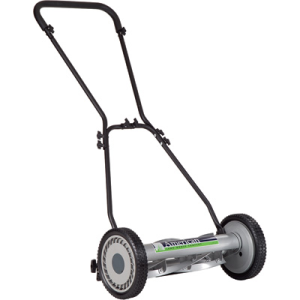 Should I Bag or Mulch the Clippings?
Should I Bag or Mulch the Clippings? I use Preen on our perennial beds and shrub borders. I think Mrs. BD, the Weeder-in-Chief, appreciates it, but my Mom gives me heck for using it since she views it as lazy and possibly not environmentally acceptable.
I use Preen on our perennial beds and shrub borders. I think Mrs. BD, the Weeder-in-Chief, appreciates it, but my Mom gives me heck for using it since she views it as lazy and possibly not environmentally acceptable.  Lawns are dumb things to have, but almost everybody has some. It's expected nowadays, but gardens and plantings are more interesting, look more natural, are more inviting to birds and other friendly critters, and offer more privacy - and shade. On the other hand, everyone needs a space for croquet and badminton.
Lawns are dumb things to have, but almost everybody has some. It's expected nowadays, but gardens and plantings are more interesting, look more natural, are more inviting to birds and other friendly critters, and offer more privacy - and shade. On the other hand, everyone needs a space for croquet and badminton. 

 Anybody who took my advice about growing Montauk Daisies, the succulent daisy which is a cultivar of the Seaside Daisy (common on Cape Cod, and totally different from the West Coast's beach daisy), is missing one piece of info which I have learned only now.
Anybody who took my advice about growing Montauk Daisies, the succulent daisy which is a cultivar of the Seaside Daisy (common on Cape Cod, and totally different from the West Coast's beach daisy), is missing one piece of info which I have learned only now. Mrs. BD reports today, after trying Gibbs' recommendation, that a paste of vinegar and baking soda is quite effective for poison ivy. (Remember McGeek's case of poison ivy?)
Mrs. BD reports today, after trying Gibbs' recommendation, that a paste of vinegar and baking soda is quite effective for poison ivy. (Remember McGeek's case of poison ivy?) 